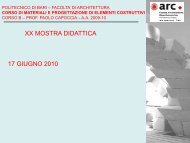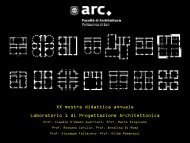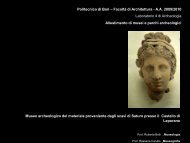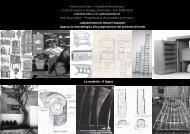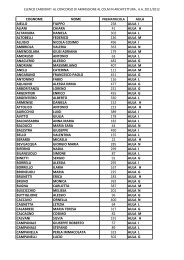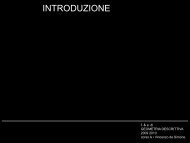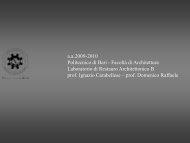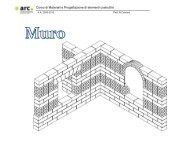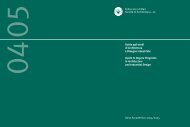Scarica il file pdf - Politecnico di Bari
Scarica il file pdf - Politecnico di Bari
Scarica il file pdf - Politecnico di Bari
You also want an ePaper? Increase the reach of your titles
YUMPU automatically turns print PDFs into web optimized ePapers that Google loves.
Laboratorio <strong>di</strong> Disegno industriale 1/IIndustrial Design Stu<strong>di</strong>o 1/ILDI 1/I-7,5 cfu1° anno / corso semestrale (I semestre)Area <strong>di</strong>dattica I:Progetto del prodotto industriale:• Icar 13, Disegno industriale• Icar 16, Architettura degli interniRoberto PerrisDisegno industriale 1/I (Icar 13-5 cfu)Massim<strong>il</strong>iano ReinaDisegno del prodotto industriale (Icar 17-2,5 cfu)Finalità e contenuti <strong>di</strong>sciplinariIl corso è rivolto ad introdurre gli studentiai fondamenti del Design.Aims and contentsThe objectives of the course is to introducethe students to the basics of industrialDesign.Articolazione delle attività <strong>di</strong>dattiche• L’insegnamento teorico prevederà lezionivolte ad analizzare le linee evolutive <strong>di</strong>alcuni sistemi produttivi e ne <strong>il</strong>lustreràl’applicazioni a casistiche significative dellastoria del Design, sia in termini <strong>di</strong>innovazione del prodotto, sia in termini <strong>di</strong>organizzazione, razionalizzazione edottimizzazione delle prestazioni dei sistemiartigianali evoluti ed industriali.• Le applicazioni saranno volte asperimentare, analizzare criticamente,scomporre e ricomporre oggetti o parti <strong>di</strong>oggetti, per riconoscerne e restituirne,me<strong>di</strong>ante elaborati appropriati: sistemi eparti componenti, modalità <strong>di</strong> montaggio,efficienza prestazionale e produttiva.Alla fine del corso, gli studenti devonoessere capaci <strong>di</strong> progettare semplici oggettid’uso.Articulation of the educational activities• The theoretical learning consists oflessons that analyze the evolutionary linesof some productive systems. They also<strong>il</strong>lustrate their applications in the history ofdesign, both in terms of innovation of theproduct, and in terms of organization,rationalization and optimization of theperformance of evolved industrial andhan<strong>di</strong>craft systems.-The exercises w<strong>il</strong>l analyse criticallyobjects or parts of objects, in order toreconstruct them using appropriatemodels: systems and component parts, Atthe end of the course the students must beable to design simple objects.Iscrizione al corsoLe iscrizioni avvengono obbligatoriamentesulla piattaforma entro i primi <strong>di</strong>eci giornidall’inizio dei corsi.Modalità d’esameL’esame si baserà sulla valutazione delgrado <strong>di</strong> conoscenza raggiunto dallostudente in merito ai temi trattati nel corso,e documentati nella bibliografia allegata alprogramma particolareggiato e nei“Complementi <strong>di</strong> tecnologia per <strong>il</strong> C.d.L. inDisegno industriale” (consegnati nel corso).Si baserà inoltre sulla valutazione del grado<strong>di</strong> interesse, <strong>di</strong> competenza e <strong>di</strong>compiutezza riscontrati nelle esercitazionisvolte.Laboratorio <strong>di</strong> Arredamento 1/IInterior Design Stu<strong>di</strong>o 1/ILA 1/I-7,5 cfu1° anno / corso semestrale (I semestre)Area <strong>di</strong>dattica I:Progetto del prodotto industriale:• Icar 13, Disegno industriale• Icar 16, Architettura degli interniAnnalisa <strong>di</strong> RomaProgettazione del prodotto <strong>di</strong> arredo 1/I(Icar 13-5 cfu)Marcella MarroneDisegno del prodotto d’arredo (Icar 14-2,5cfu)Finalità e contenuti <strong>di</strong>sciplinariObiettivo del corso è far acquisire allostudente la consapevolezza delle <strong>di</strong>verseforme e tipi <strong>di</strong> legno nell’arredo e <strong>di</strong>introdurlo alla teoria e alla praticarealizzativa del prodotto d’arredo. Sarannoanalizzati alcuni oggetti significativi perquanto riguarda l’evoluzione del rapportotra forma-tecnica-materia del prodottod’arredo; dall’altra attraverso la messa apunto <strong>di</strong> un progetto esecutivo <strong>di</strong> replica <strong>di</strong>una se<strong>di</strong>a d’autore.Lo stu<strong>di</strong>o delle forme e dei tipi degli arre<strong>di</strong>in legno sarà condotto su tre tipi <strong>di</strong> se<strong>di</strong>ed’autore (se<strong>di</strong>a ed elementi piani, se<strong>di</strong>a adelementi curvi e torniti, se<strong>di</strong>a ad elementiplastici) e costituirà <strong>il</strong> momento dellariflessione analitica (sapere).L’appren<strong>di</strong>mento e l’uso degli strumentiinformatici <strong>di</strong> modellazione, larappresentazione e la gestione informaticadella fase costruttiva dei modelli (prototipivirtuali) costituiranno <strong>il</strong> training <strong>di</strong>appren<strong>di</strong>mento degli strumenti (saperfare).Aims and contentsTarget of the course is to make thestudents aware of the <strong>di</strong>fferent forms andtypes of wood in interior design and tointroduce them to the theory and practiceof interior design. Some significant objectsare analysed from the point of view of theevolution of the relationship between form,technique and material of interior design.The second part involves executive designreplica of an designer chair.The study of the forms and the types ofwood elements in interior design isconducted on three types of designerchairs (chair with plain elements, chair withbends and turned elements, chair withplastic elements) and it consists ofanalytical reflection (knowledge).The learning and the use of computermodelling tools, representation andcomputer management of the constructionphase of the models (virtual prototypes)involves training in the use of tools(knowhow).Articolazione delle attività <strong>di</strong>datticheIl corso è organizzato in quattro moduli<strong>di</strong>dattici <strong>il</strong> cui oggetto corrisponde ai<strong>di</strong>versi approcci formali, tecnici etecnologici, assunti a riferimento per lacomprensione dell’oggetto del temad’anno.Articulation of the educational activitiesThe course is organized in four <strong>di</strong>dacticmodules correspon<strong>di</strong>ng to the <strong>di</strong>fferentformal, technical and technological44.3.20 Progetti <strong>di</strong>dattici 1° anno137




